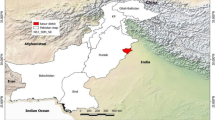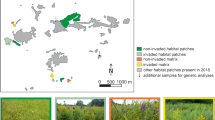Abstract
We studied patterns of variation in species composition of flea assemblages on small mammals across different habitats of Slovakia and compared flea species composition within and across host species among habitats. We asked (1) how variable the composition of flea assemblages is among different populations of the same host occurring in different habitats and (2) whether the composition of flea assemblages in a habitat is affected either by species composition of hosts or by environmental affinities of this habitat. Between-habitat similarity in flea species composition increased with an increase in the similarity in host species composition. Species richness of flea assemblages of a host species correlated positively with mean number of cohabitating host species but not with the number of habitats occupied by a host species. Results of the ordination of flea collections from each individual host demonstrated that the first five principal components explained most of the variance in species composition of flea assemblages. The segregation between rodent and insectivore flea assemblages was easily discerned from the ordination diagram when flea assemblages were plotted according to their hosts. When flea assemblages were plotted according to their habitat affinities, the distinction of habitats based on variation in flea composition was not as clear. The results of ANOVA of each principal component showed the significant effect of both host species and habitat type. The variation in each principal component was explained better by the factor of host species compared with the factor of habitat type. Multidimensional scaling of flea assemblages within host species across habitats demonstrated that among-habitat variation in flea composition was manifested differently in different hosts.





Similar content being viewed by others
References
Bell G, Burt A (1991) The comparative biology of parasite species diversity: intestinal helminths of freshwater fishes. J Anim Ecol 60:1046–1063
Bray JR, Curtis JT (1957) An ordination of the upland forest communities of southern Wisconsin. Ecol Monogr 27:325–349
Brooks DR, McLennan DA (1991) Phylogeny, ecology, and behavior: a research program in comparative biology. University of Chicago Press, Chicago
Buchman K (1991) Relationship between host size of Anguilla anguilla and the infection level of the monogeneans Pseudodactylogyrus spp. J Fish Biol 35:599–601
Bush AO, Holmes JC (1986) Intestinal helminths of lesser scaup ducks: an interactive community. Can J Zool 64:142–152
Calvete C, Blanco-Aguiar JA, Virgós E, Cabezas-Díaz S, Villafuerte R (2004) Spatial variation in helminth community structure in the red-legged partridge (Alectoris rufa L.): effects of definitive host density. Parasitology 129:101–113
Carney JP, Dick TA (2000) Helminth community in yellow perch (Perca flavescens (Mitchill)): determinants of pattern. Can J Zool 78:538–555
Caro A, Combes C, Euzet L (1997) What makes a fish a suitable host for Monogenea in the Mediterranean. J Helminthol 71:203–210
Clarke KR, Gorley RN (2001) Primer v5: user manual/tutorial. Primer-E, Plymouth Marine Laboratory, Plymouth
Clarke KR, Warwick RM (2001) Change in marine communities: an approach to statistical analysis and interpretation, 2nd edn. Primer-E, Plymouth Marine Laboratory, Plymouth
Combes C (2001) Parasitism. The ecology and evolution of intimate interactions. University of Chicago Press, Chicago
Day JF, Benton AH (1980) Population dynamics and coevolution of adult siphonapteran parasites of the southern flying squirrel (Glaucomys volans volans). Am Midl Nat 103:333–338
Felsenstein J (1985) Phylogenies and the comparative method. Am Nat 125:1–15
Galaktionov KV (1996) Life cycles and distribution of seabird helminthes in Arctic and subarctic regions. Bull Scand Soc Parasitol 6:31–49
Garland T Jr, Harvey PH, Ives AR (1992) Procedures for the analysis of comparative data using phylogenetically independent contrasts. Am Nat 41:8–32
Guégan J-F, Lambert A, Leveque C, Euzet L (1992) Can host body size explain the parasite species richness in tropical freshwater fishes? Oecologia 90:197–204
Kennedy CR, Bush AO (1994) The relationship between pattern and scale in parasite communities: a stranger in a strange land. Parasitology 109:187–196
Kern WH, Richman DL, Koehler PG, Brenner RJ (1999) Outdoor survival and development of immature cat fleas (Siphonaptera: Pulicidae) in Florida. J Med Entomol 36:207–211
Krasnov BR, Khokhlova IS (2001) The effect of behavioural interactions on the transfer of fleas (Siphonaptera) between two rodent species. J Vector Ecol 26:181–190
Krasnov BR, Shenbrot GI, Medvedev SG, Vatschenok VS, Khokhlova IS (1997) Host–habitat relation as an important determinant of spatial distribution of flea assemblages (Siphonaptera) on rodents in the Negev Desert. Parasitology 114:159–173
Krasnov BR, Shenbrot GI, Medvedev SG, Khokhlova IS, Vatschenok VS (1998) Habitat-dependence of a parasite–host relationship: flea assemblages in two gerbil species of the Negev Desert. J Med Entomol 35:303–313
Krasnov BR, Khokhlova IS, Fielden LJ, Burdelova NV (2001) The effect of temperature and humidity on the survival of pre-imaginal stages of two flea species (Siphonaptera: Pulicidae). J Med Entomol 38:629–637
Krasnov BR, Khokhlova IS, Oguzoglu I, Burdelova NV (2002a) Host discrimination by two desert fleas using an odour cue. Anim Behav 64:33–40
Krasnov BR, Khokhlova IS, Fielden LJ, Burdelova NV (2002b) The effect of substrate on survival and development of two species of desert fleas (Siphonaptera: Pulicidae). Parasite 9:135–142
Krasnov BR, Sarfati M, Arakelyan MS, Khokhlova IS, Burdelova NV, Degen AA (2003) Host-specificity and foraging efficiency in blood-sucking parasite: feeding patterns of a flea Parapulex chephrenis on two species of desert rodents. Parasitol Res 90:393–399
Krasnov BR, Shenbrot GI, Khokhlova IS, Degen AA (2004a) Relationship between host diversity and parasite diversity: flea assemblages on small mammals. J Biogeogr 31:1857–1866
Krasnov BR, Khokhlova IS, Burdelova NV, Mirzoyan NS, Degen AA (2004b) Fitness consequences of density-dependent host selection in ectoparasites: testing reproductive patterns predicted by isodar theory in fleas parasitizing rodents. J Anim Ecol 73:815–820
Krasnov BR, Shenbrot GI, Khokhlova IS, Poulin R (2004c) Relationships between parasite abundance and the taxonomic distance among a parasite’s host species: an example with fleas parasitic on small mammals. Int J Parasitol 34:1289–1297
Krasnov BR, Burdelova NV, Khokhlova IS, Shenbrot GI, Degen AA (2005) Pre-imaginal interspecific competition in two flea species parasitic on the same rodent host. Ecol Entomol 30:146–155
Kruskal JB, Wish M (1978) Multidimentional scaling. Sage, Beverly Hills
Kucheruk VV (1983) Mammal burrows: their structure, topology and use (in Russian). Fauna Ecol Rodents 15:5–54
Legendre P, Legendre L (1998) Numerical ecology, 2nd edn. Elsevier, Amsterdam
Maddison WP, Maddison DR (2004) Mesquite: a modular system for evolutionary analysis, version 1.05. http://mesquiteproject.org
Marshall AG (1981) The ecology of ectoparasitic insects. Academic, London
Midford PE, Garland T Jr, Maddison WP (2004) PDAP:PDTREE package for Mesquite, version 1.06. http://mesquiteproject.org/pdap_mesquite/index.html
Morand S, Gouy de Bellocq J, Stanko M, Miklisova D (2004) Is sex-biased ectoparasitism related to sexual size dimorphism in small mammals of Central Europe? Parasitology 129:505–510
Poulin R (1998) Evolutionary ecology of parasites. From individuals to communities. Chapman and Hall, London
Poulin R, Valtonen T (2002) The predictability of helminth community structure in space: a comparison of fish populations from adjacent lakes. Int J Parasitol 32:1235–1243
Rödl P (1979) Investigation of the transfer of fleas among small mammals using radioactive phosphorus. Folia Parasitol 26:265–274
Rosenzweig ML (1995) Species diversity in space and time. Cambridge University Press, Cambridge
Ryckman RE (1971) Plague vector studies. Part I. The rate of transfer of fleas among Citellus, Rattus and Sylvilagus under field conditions in southern California. J Med Entomol 8:535–540
Shenbrot GI, Krasnov BR, Rogovin KA (1999) Spatial ecology of desert rodent communities. Springer, Berlin Heidelberg New York
Shenbrot GI, Krasnov BR, Khokhlova IS, Demidova T, Fielden LJ (2002) Habitat-dependent differences in architecture and microclimate of the Sundevall’s jird (Meriones crassus) burrows in the Negev Desert, Israel. J Arid Environ 51:265–279
Sokal RR, Rohlf FJ (1995) Biometry, 3rd edn. W.H. Freeman, New York
Stanko M (1987a) Siphonaptera of small mammals in the northern part of the Krupina plain (in Slovakian). Stred Slov Zborn Stredoslov Múz Bansk Bystr 6:108–117
Stanko M (1987b) Fleas (Siphonaptera) of small mammals from Javorie mountains (in Slovakian). Acta Res Nat Mus Nat Slov 33:95–108
Stanko M (1988) Fleas (Siphonaptera) of small mammals in eastern part of Volovské vrchy mountains (in Slovakian). Acta Res Nat Mus Nat Slov 34:29–40
Stanko M (1994) Fleas synusy (Siphonaptera) of small mammals from the central part of the East-Slovakian lowlands. Biologia (Bratislava) 49:239–246
Stanko M, Miklisova D, Gouy De Bellocq J, Morand S (2002) Mammal density and patterns of ectoparasite species richness and abundance. Oecologia 131:289–295
Sukhdeo MVK (1997) Earth’s third environment: the worm’s eye view. Bioscience 47:141–149
Ward SA (1992) Assessing functional explanations of host specificity. Am Nat 139:883–891
Acknowledgements
We thank L. Mošanský and J. Fričová for their help in the field. Allan Degen (Ben-Gurion University of the Negev) and two anonymous referees read the earlier version of the manuscript and made helpful comments. This study was partly supported by the Slovak Grant Committee VEGA (grant no. 2/5032/25 to Michal Stanko). The manipulations comply with the laws of the Slovak Republic. This is publication no. 191 of the Ramon Science Center and no. 497 of the Mitrani Center of Desert Ecology.
Author information
Authors and Affiliations
Corresponding author
Appendix
Appendix
Fleas and small mammals collected in different habitat types in Slovakia
Habitat type | Small mammals | Fleas |
|---|---|---|
Lowland river valleys | Apodemus agrarius, Apodemus flavicollis, Apodemus uralensis, Apodemus sylvaticus, Clethrionomys glareolus, Microtus arvalis, Microtus subterraneus, Neomys anomalus, Neomys fodiens, Sorex alpinus, Sorex araneus | Amphipsylla rossica, Ctenophthalmus agyrtes, Ctenophthalmus assimilis, Ctenophthalmus bisoctodentatus, Ctenophthalmus solutus, Ctenophthalmus uncinatus, Doratopsylla dasycnema, Hystrichopsylla orientalis, Megabothris turbidus, Nosopsyllus fasciatus, Palaeopsylla similis, Palaeopsylla soricis, Peromyscopsylla bidentata, Rhadinopsylla pentacantha |
Lowland woodland belts | A. agrarius, A. flavicollis, A. uralensis, A. sylvaticus, C. glareolus, M. arvalis, M. subterraneus, N. fodiens, S. araneus | Amalaraeus arvicolae, C. agyrtes, C. assimilis, C. bisoctodentatus, C. solutus, D. dasycnema, H. orientalis, Leptopsylla segnis, M. turbidus, N. fasciatus, P. similis, P. soricis, P. bidentata |
Lowland agricultural fields | A. agrarius, A. flavicollis, A. uralensis, A. sylvaticus, Mus musculus, C. glareolus, M. arvalis, M. subterraneus | C. agyrtes, C. assimilis, C. solutus, D. dasycnema, H. orientalis, L. segnis, M. turbidus, N. fasciatus, P. soricis |
Lowland forests | A. agrarius, A. flavicollis, C. glareolus, M. arvalis, M. subterraneus, S. araneus | C. agyrtes, C. assimilis, C, solutus, D. dasycnema, H. orientalis, L. segnis, M. turbidus, N. fasciatus, P. soricis, P. bidentata |
Lowland shrubbery | A. agrarius, A. flavicollis, A. uralensis, C. glareolus, M. subterraneus, N. anomalus, S. araneus | C. agyrtes, C. assimilis, C, solutus, H. orientalis, M. turbidus, N. fasciatus, P. soricis |
Mountain river valleys | A. agrarius, A. flavicollis, A. uralensis, A. sylvaticus, Micromys minutus, C. glareolus, M. arvalis, M. subterraneus, Muscardinus avellanarius, N. anomalus, N. fodiens, S. alpinus, S. araneus | A. arvicolae, Amalaraeus penicilliger, A. rossica, Atyphloceras nuperus, C. agyrtes, C. assimilis, C. bisoctodentatus, C. solutus, C. uncinatus, Ceratophyllus sciurorum, D. dasycnema, H. orientalis, Hystrichopsylla talpae, L. segnis, M. turbidus, N. fasciatus, Palaeopsylla kohauti steini, P. similis, P. soricis, P. bidentata, Peromyscopsylla silvatica, Rhadinopsylla integella, Rhadinopsylla isacantha, R. pentacantha |
Mountain forests | A. agrarius, A. flavicollis, A. uralensis, A. sylvaticus, C. glareolus, M. arvalis, M. subterraneus, M. avellanarius, N. anomalus, S. alpinus, S. araneus | A. arvicolae, A. penicilliger, A. rossica, A. nuperus, C. agyrtes, C. assimilis, C. solutus, C. uncinatus, Ceratophyllus sciurorum, D. dasycnema, H. orientalis, H. talpae, L. segnis, M. turbidus, N. fasciatus, P. similis, P. soricis, P. bidentata, P. silvatica, R. integella, R. isacantha, R. pentacantha |
Mountain shrubbery | A. flavicollis, A. sylvaticus, C. glareolus, M. arvalis, M. subterraneus, M. avellanarius, N. fodiens, S. araneus | A. penicilliger, A. rossica, C. agyrtes, C. assimilis, C. bisoctodentatus, C. solutus, C. sciurorum, D. dasycnema, M. turbidus, N. fasciatus, P. k. steini, P. similis, P. soricis, P. bidentata, R. integella, R. isacantha, R. pentacantha |
Urban habitats | A. flavicollis, M. musculus, M. arvalis, | C. agyrtes, C. assimilis, C. solutus, L. segnis, M. turbidus |
About this article
Cite this article
Krasnov, B.R., Stanko, M., Miklisova, D. et al. Habitat variation in species composition of flea assemblages on small mammals in central Europe. Ecol Res 21, 460–469 (2006). https://doi.org/10.1007/s11284-005-0142-x
Received:
Accepted:
Published:
Issue Date:
DOI: https://doi.org/10.1007/s11284-005-0142-x




